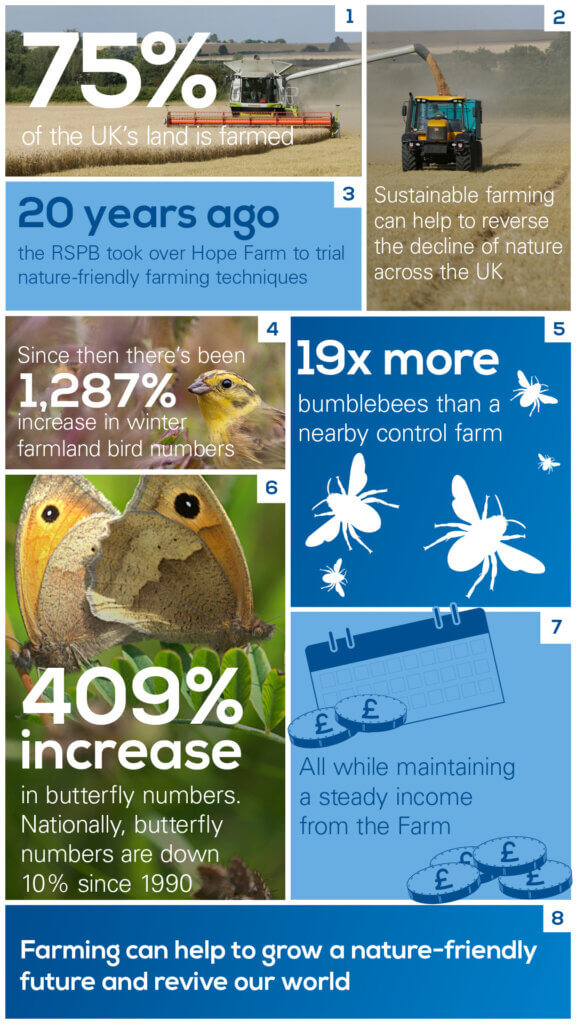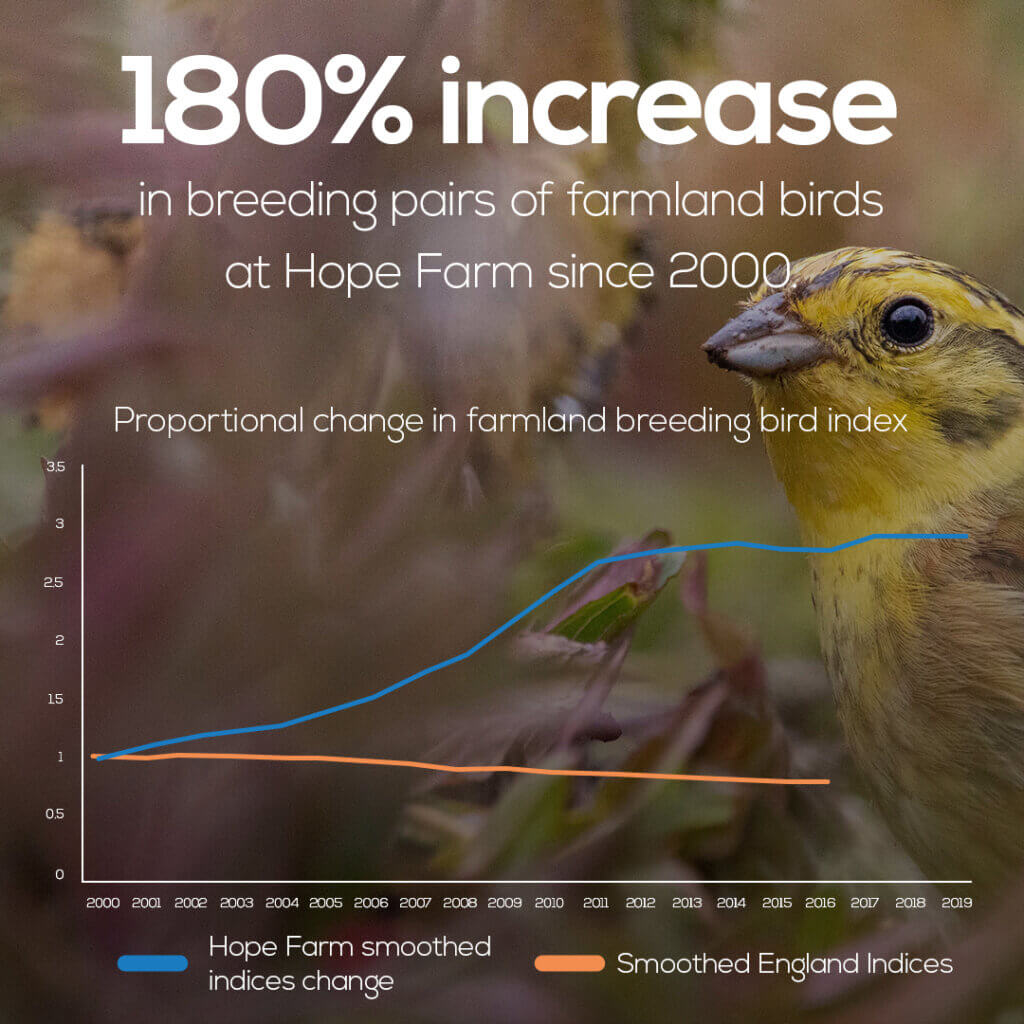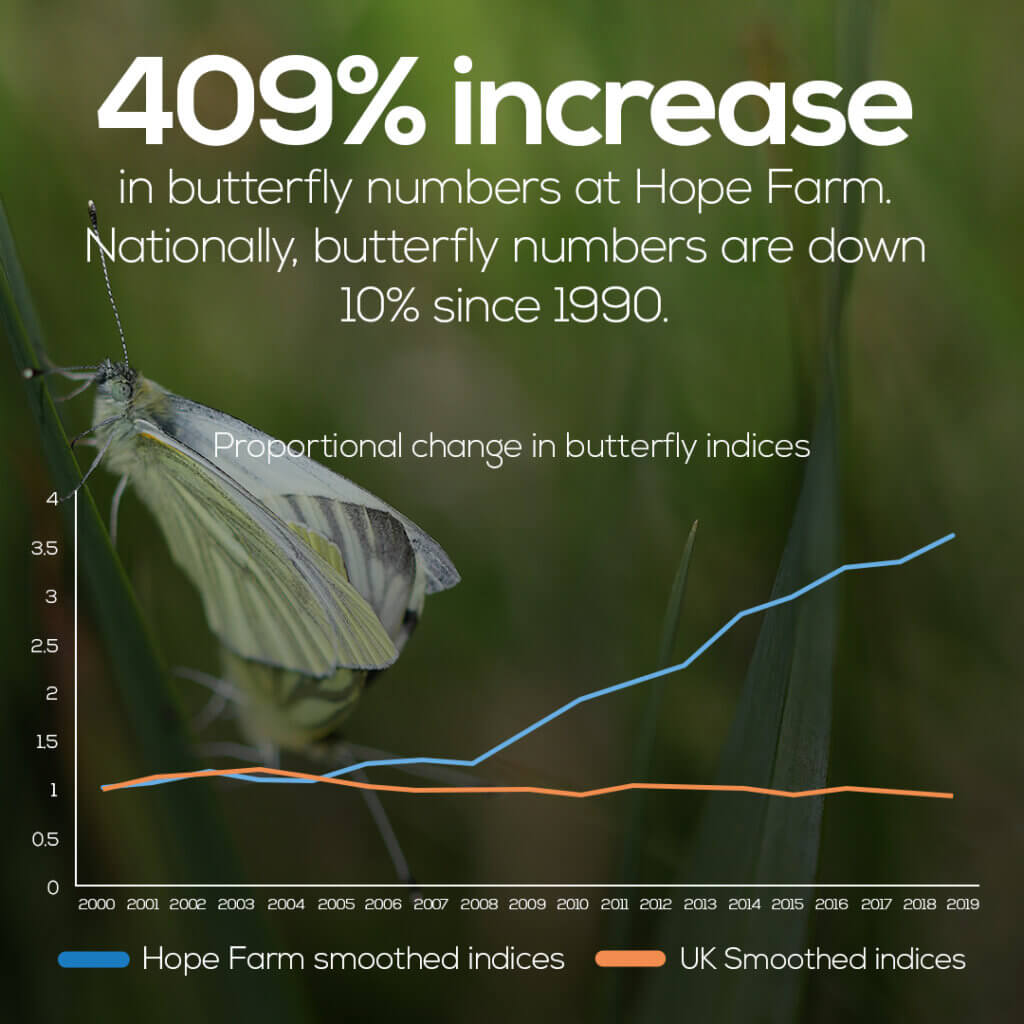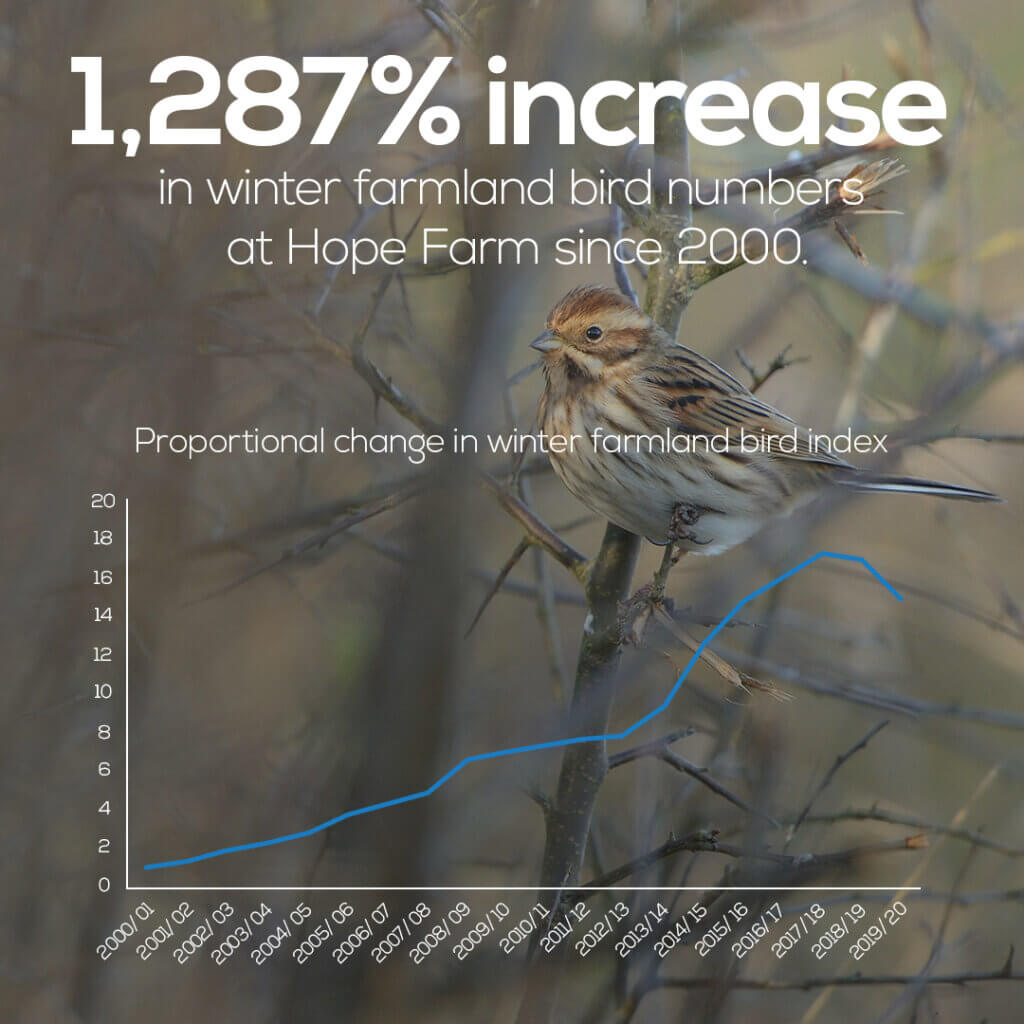Two decades of nature friendly farming see bird numbers soar more than ten times

- Nature-friendly farming practices have seen butterfly numbers quadruple, winter farmland bird numbers rise 1,200% and given a massive boost to bumblebees while turning a profit
- Farmland covers 75% of the UK making it vital in the fight to reverse nature’s decline
- The RSPB is concerned the UK government is turning its back on promises to transform farming policy as the Agriculture Bill enters its final stages in parliament
Twenty years of nature-friendly farming at the RSPB’s Hope Farm has shown that with the right support it possible to produce healthy food that’s good for people, the climate and our wildlife. However, the future of farming and the incredible wildlife that call our farmlands home hangs in the balance as the UK Government has started drawing up new plans rowing back on pledges made to farmers and for nature.

Adopting nature-friendly farming techniques, the RSPB’s Hope Farm in Cambridgeshire has demonstrated it is possible to reverse the declines in farmland wildlife and maintain a sustainable and profitable business if farmers are given the right support.
On the farm in Cambridgeshire, wildlife numbers have skyrocketed over the past two decades, while the business has continued to maintain a steady profit. Simple actions such as growing wildflowers, creating ponds, improving soils and cutting out insecticides boosted wildlife, show how the future for farming and nature in the UK could look.

Butterfly numbers are up 409%, compared to a 10% decrease nationally since 1990, and there are 19 times as many bumblebees on Hope Farm than a nearby control farm. There are now regular sightings of endangered farm birds such as the lapwing, grey partridge, linnet and yellow wagtail, which were never recorded on the farm 20 years ago, and winter farmland birds are up by more than1,200%.
With the England Agriculture Bill returning to the House of Commons this month, the RSPB is urging the UK Government to draw on this experience to guide the development of new agriculture legislation and nature-friendly farming schemes in England.
Jenna Hegarty, RSPB Deputy Director for Conservation said: “The government must wake up and smell the coffee – Hope Farm has proved our farms can become havens for wildlife and maintain profit if farmers are given the right support.
We have reached a fork in the road – the UK Government can rebrand failed policy and face another lost decade for nature. Or they can seize this once-in-a-generation opportunity to transform the way we farm; supporting and rewarding farmers for protecting our precious wildlife. The stakes could not be higher. The UK Government must stand by its promise to rewrite the future for farming and nature to help revive our world.”
Nature is in crisis: 15% of UK species are at risk of extinction, and the Farmland Bird Index has dropped by 57% since 1970. The UK is languishing near the bottom of the league table as one of the most nature depleted countries in the world. Farmland covers 75% of the UK, meaning farmers are critical to efforts to restore nature and tackle the climate crisis.
Whilst an increasing number of farmers are supporting nature friendly farming and would like to do more (2), incentives through farm subsidy systems have done too little to support them.
Defra has started to design a new support system, the Environment Land Management Scheme (ELMS). But initial plans appear to repeat failings of the old system, lack ambition and fails to support new farming practices which work with nature.
Georgina Bray, Hope Farm Manager, said: “Farmland covers the majority of our four countries, making it an absolutely critical part of the solution if we are to reverse the decline of nature. Farmers are under a huge amount of pressure, but what’s been amazing about managing Hope Farm is that I’ve seen how nature can help to produce richer, healthier soils and crops and remain productive in the long-term.”
Chairman of the Nature Friendly Farming Network and Hope Farm contractor Martin Lines said: “It’s been great to witness and support the turnaround of nature at Hope Farm. The huge increase in butterfly numbers, birds and other wildlife is an incredible achievement. The benefits of nature-friendly farming practices not only produce amazing results for nature and the environment but also deliver fantastic benefits for farming productivity.”

ENDS
[registration_form]
Well done them. If only this mindless government will listen.
Great new wake up government and do what needs to be done. Hope farm leading the way forward. Keep up the good work.
Wonderful proof if it was needed that nature only needs a fair chance and it can begin to repair itself.
That’s great to hear. Congratulations to the RSPB. The way forward must be for both farming to be profitable and for wildlife to increase. The decline of farmland birds over the last fifty years is tragic. A decline of which the ground nesting lapwing and ground nesting grey partridge mentioned have been amongst the steepest. Whilst recent years have seen a welcome increase in habitat creation such as that at Hope Farm sadly the decline of farmland birds which, in biological terms, is ultimately due to a lack of reproductive success, has not been reversed. A decline which has been accompanied by a correspondingly large increase in ground feeding predators during the same fifty years. Any thoughts anyone?
Philip – hello! Yes, people should stop feeding generalist predators with Pheasants.
But at Hope Farm, at least for the first 11 years of the 20 covered here for which I have good knowledge, there was no predator control carried out on site and not much by the neighbours. So, you might say all the more remarkable?
And as you will no doubt recall, Hope Farm outperformed Loddington even when Loddington employed a gamekeeper see https://markavery.info/2015/11/05/high-hope/
Mark your usual left wing socialist political agenda coming to the fore. You clearly just use birds and the rspb to further your political agenda. Shame on you you inadequate individual.
Mike – and you are clearly more than slightly confused.
Mike the Parrot’s been on the pop again!
Maybe they should start brood meddling Skylarks and Corn Buntings? Oh, I forgot, Neither species eat “gamebirds”.
Well done Hope Farm. I am a farmer and RSPB Life Fellow. We had great support during our 10yrs of HLS agreement and in the (very difficult) application process for the new Mid Tier scheme from the local RSPB farming advisor. Unfortunately they have done away with this dedicated service.
Charles – thank you for your first comment here. That is a shame, I agree.
Thanks Mark. As someone who doesn’t shoot and never has shot, I’m not aiming to get into a debate about your point about numbers of pheasants released. More to make the point about the risks of creating an ecological trap (habitat trap) if ground nesting birds such as lapwing and grey partridge are attracted to a site through habitat creation such as at Hope Farm, which I fully support, but then have their eggs or chicks taken by ground feeding predators. Resulting in a lack of reproductive success and hence a decline in overall population.
Philip – well I don’t shoot either, but I, like you, am interested in why the UK has exceptionally high numbers of some predatory species and some scaengers. It might be meso-predator release because we got rid of larger predators (maybe we should put some back?) or it might be something to do with the way we farm (you’re a farmer aren’t you? What do you think?) or it might be that we release tens of millions of meat packages into the countryside each year. You raised the issue, which wasn’t the subject of the post, and now you seem strangely unwilling to chat about it.
And you have no evidence, or do you?, that Hope Farm is an ecological trap. That seems unduly speculative to em. Almost unwarranted. Perhaps merely nasty? As I recall, GWCT lost their Grey Partridges from Loddington and RSPB gained them at Hope Farm but I may be out of date. Do you have the breeding success figures for Hope Farm close at hand, if so please share them.
The point made in my comment above was that I very much welcome and support the excellent work that the RSPB have carried out regarding habitat creation at Hope Farm and pointed out that there might be a risk of creating an ecological trap (habitat trap) by creating habitat for ground nesting birds such as lapwing and grey partridge mentioned in the press release and then not controlling ground feeding predators. Yes indeed I am a farmer and am one who happens to be accredited to manage National Nature Reserves for, amongst other things, ground nesting birds. Which has made me aware of the risk to the fledging success of such birds by not taking account of the possibility of creating an ecological trap. Surely, what unites us is that we both want to reverse the tragic decline of farmland birds and are prepared to explore all possible factors that might (and I say might) be preventing this.
And there surely can be no excuse not to explore the introduction of twice the biomass of all our native birds into the countryside every year ? This, I have to say, was one of those rare eye-opening moments for me. It is huge, out of proportion to most of the other speculative causes that are being debated. And I’m also sure you are trying to make a point which undermines the Hope Farm achievement, Philip, but it’s so obtuse I can’t quite spot what it is.
Hello Roderick. I have just read back through my three comments above and they seem pretty clear to me. If you feel that they are obtuse that’s not what’s intended.
As I’m aware that, like me, you are very keen on birds of prey, I thought that you might like to know that last January, the BTO monthly harrier winter roost count at Elmley recorded the quite extraordinary figure of 152 harriers on the reserve. Most of which were roosting in a reedbed (known as the Brickfields) which we created a little over thirty years ago. I am told that this may well be due to the harriers not being disturbed by foxes and hence feeling secure due to the predator exclusion fence which we put up around the reserve for the breeding waders.